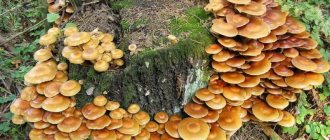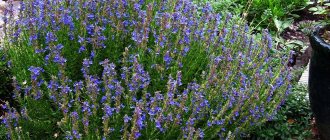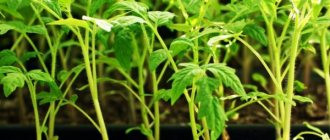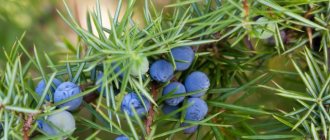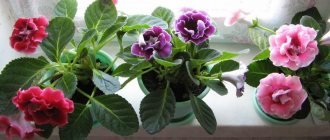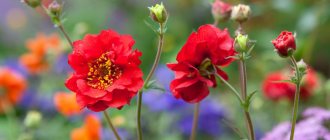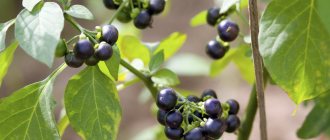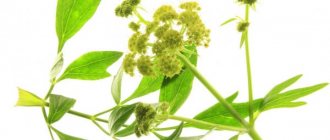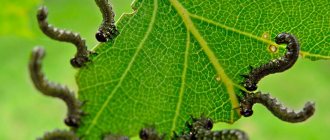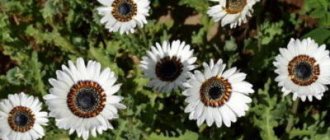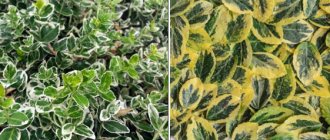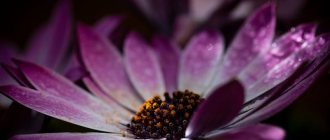Advantages and disadvantages of the method
Let us describe the advantages and disadvantages of the seed propagation method.
Pros:
- A simple method that a beginner can handle.
- Seeds remain viable for up to three years.
- Seedlings grown from seeds are hardy and resistant to changing weather conditions. The method is effective for cold regions of Russia.
- Sometimes seedlings are superior to their parents in decorative qualities; these plants are used by breeders.
- Cheap method: seeds are 8-10 times cheaper than seedlings.
Minuses:
- Seedlings bloom in 4-9 years.
- The decorative properties of the vine are not always preserved.
- Poor quality seeds have a germination rate of 25-30%.
WHERE IS IT BETTER TO PLANT WISTERIA
You need to immediately plant the wisteria in a permanent place - near the southern wall of a building or a solid brick (concrete) fence. A wall heated by the daytime sun will radiate heat at night, warming the plant and minimizing diurnal temperature changes.
Wisteria usually lives for 50 years or more, blooming in full force only in a sunny, windless area in the presence of moderately moist, fertile soil with an acidic reaction. If the soil on the site does not meet the specified requirements, then the planting hole must be filled with a purchased soil mixture for vines. This will be the key to rapid establishment and growth of the young seedling. Since wisteria loves moisture, but does not tolerate stagnation of water, in constantly damp areas, the soil must be drained before planting the vine. Try to choose an area where the root of the plant is in the shade and the vine itself is in the sun. In nature, it grows this way, stretching from the darkness towards the sun.
How to select and prepare land for planting?
In order for the seeds to sprout strong shoots, we prepare the soil. Wisteria loves light, loose soil, saturated with air, slightly alkaline with a minimum lime content. When choosing purchased soil, pay attention to the composition. Wisteria does not tolerate calcareous soils. Excessive lime causes the leaves on the shoots to lighten and lose their decorative effect.
Soil for propagation by seeds: peat, humus, turf soil and sand. We prepare in the ratio 1:1:1:3.
Wisteria loves moist soil, but not saturated with moisture! When preparing the land for sowing seeds, create optimal humidity using drainage. In swampy soil, the roots of an adult vine rot, and the seeds will not sprout.
Wisteria: planting and care, growing from seeds
Natalya Category: Garden plants: February 20, 2019Added: November 21, 2019
flowers (Greek Glicinia - “sweet”) , or wisteria (lat.
Wisteria), belong to the genus of tree-like climbing plants of the Legume family, growing in subtropical regions and attracting attention with their fragrant, hanging purple inflorescences.
The Latin name “wisteria” was given to the wisteria flower in honor of the professor of anatomy at the University of Pennsylvania Caspar Wistar. There are 9 known species of the wisteria genus, but only Chinese wisteria and Japanese wisteria, or abundantly flowering, are grown as garden crops.
- Planting: sowing seeds in the ground - in early spring, for seedlings - in December, planting seedlings in the ground - in May.
- Flowering: from late March to late summer.
- Lighting: bright sun in the first half of the day, then diffused light or partial shade.
- Soil: nutritious, well-drained, slightly alkaline.
- Watering: from spring to late summer - moderate: the soil in the tree trunk circle should be slightly moist all the time, and from mid-September watering is gradually reduced.
- Feeding: during the growing season, once a week alternately with mineral and organic solutions.
- Pruning: in summer, to maintain the shape of the bush.
- Reproduction: sometimes by seeds, but more often by layering.
- Pests: clover mites, aphids.
- Diseases: chlorosis.
Read more about growing wisteria below.
Wisteria floribunda
It is also colloquially “Japanese”, since it comes from the Japanese islands - it differs from the Chinese one in its smaller size (only 8-10 m in length), larger leaves up to 40 cm in length and the number of leaves up to 19, a large number of inflorescences on the plant, and also their larger sizes - up to 50 cm in length. The flowers themselves are smaller than those of Chinese wisteria, violet-blue in color, and bloom gradually, starting from the base of the cluster. This species is more cold-hardy than Chinese wisteria. There are garden forms with white, pink, purple double flowers and a variegated form with variegated leaves.
In addition to these two most popular species, beautiful wisteria (Wisteria venusta), bush wisteria (Wisteria frutescens) and large-tasted wisteria (Wisteria macrostachys) are also known in cultivation, on the basis of which American gardeners from Minnesota developed Blue Moon wisteria, which can winter in the garden even without shelters.
4.5257731958763 1 1 1 1 1 4.53 (97 votes)
Sections: Garden plants Perennials Flowering Shrubs Garden trees Lianas Plants on G Leguminous plants (Moths)
Source: https://floristics.info/ru/stati/sadovodstvo/2235-glitsiniya-posadka-i-ukhod-vyrashchivanie-iz-semyan.html
What seed looks like - photos, tips for choosing
Depending on the variety of wisteria, the color and size of the seeds differ. For example, white wisteria seeds are smaller in size than lilac ones. The characteristic shape for most seeds is round, the color ranges from dark brown to light beige with a greenish tint. Choose seeds for planting that are dry, without mold, dents or cracks.
Determine which type of vine is suitable for your climate. Let us note that out of nine species of wisteria, three take root in central Russia: Chinese wisteria, multi-flowered wisteria and shrubby wisteria. The choice of variety depends on the gardener’s color preferences, as well as on the compositional plan of the site.
In the photo you can see what wisteria seeds look like:
Rules for growing wisteria from seeds - planting, care and propagation, preparation for winter
Growing wisteria from seeds is a difficult but fascinating process. But it’s worth it, because there is no more beautiful vine in the world than wisteria wisteria. Its luxurious clusters of flowers form heavenly domes filled with a wonderful aroma. Famous gardens in Japan and China are not complete without wisteria.
Once he sees the plant splendor, the gardener firmly decides to grow wisteria on the site. Let’s find out in more detail how wisteria is grown from seeds.
What is wisteria and what does it look like?
Lat. Wisteria
The plant belongs to the legume family and is a perennial. Lianas grow up to 30-40 m in length and are tree-like branches that wrap around the host trunk or any other support.
As adults, the vines thicken so much that the tree trunk on which the wisteria is located dies. Wisteria strangles trees and is considered a parasite in nature. Upholsters the support strictly clockwise. The plant blooms from June to October, depending on the region of growth.
The inflorescences form a cluster of purple, white or lilac color. Lianas begin to bloom at 4-5 years of age, sometimes at 3. The length of flower clusters reaches 70 cm.
Wisteria grows very slowly, its average lifespan is 100 years. Therefore, it is worth giving it a place where it could grow for decades.
The foliage of the plant is dense, the leaves are large, feathery and reach a length of 30 cm.
The main habitat of wisteria is the subtropics, South America, Japan, China. She loves warmth, moisture and long daylight hours. In the northern regions, wisteria is grown in greenhouses and winter gardens.
The most popular types of wisteria in gardening are Chinese and Japanese, which bloom profusely. It is worth considering one drawback of wisteria - it is a poisonous plant. It should not be grown in the case of nearby groundwater.
Growing wisteria from seeds on the plot is not so difficult. The main thing is to provide her with living conditions and carefully look after the insidious beauty.
Wisteria growing conditions
Since Wisteria is a southern plant, it needs to be provided with appropriate conditions. The site should be selected so that the wisteria is exposed to the sun for almost the entire day. She loves sunny and even hot places, but sufficiently humidified.
House decorated with wisteria
Wisteria does not tolerate drafts. This must be taken into account when growing in greenhouses, where drafts are a frequent occurrence. In open ground, select an area protected from strong winds. The main condition for growing vines is reliable support. In nature, the plant entwines trees and lives and reproduces on them.
In the conditions of the site it is necessary to build something similar. It is better to dig the foundations into the ground and fill them with cement mortar. That is, they must be strong, otherwise the plant will squeeze them in the second or third year of life. The weight of mature thickets can reach 100 tons in large areas of growth. Keep this in mind.
If you plan to grow a stamping tree and keep it at home during the winter, you should adhere to the same conditions. In winter, the indoor air temperature should not exceed 13°.
It is necessary to observe the temperature regime, otherwise the whimsical beauty may wither or die. The substrate for wisteria should be nutritious and loose.
By observing simple growing conditions, it will be much easier for the gardener to cope with capricious wisteria.
Transplantation into open ground
Seedlings are transplanted at the end of May, when the soil has warmed up and the threat of frost has passed. To do this, prepare a hole and soil in the place chosen for wisteria. The size of the recess for the plant is 60x60 cm, depth – 50 cm.
The soil is mixed with humus, mineral fertilizers and sand are added. Instead of humus, you can use compost - wisteria will appreciate it. The soil should be fertile and loose with good drainage.
Wisteria grown from sprouts
Some gardeners cover transplanted young seedlings with film. However, it is not advisable to do this; the sprouts will not adapt well. If the location is chosen correctly, there is no strong wind, the area is sunny, there will be no problems with adaptation. Wisteria copes quite well with transplantation. The main thing is to prepare the soil correctly.
Seedlings are planted at a distance of 50 cm. Keep in mind that the plant is poisonous. Do not place wisteria near vegetable crops or fruit trees, or fish ponds.
Having transplanted the seedlings to the permanent habitat of wisteria, the gardener will only have to properly care for the southern miracle and form vines in a timely manner.
Caring for an adult plant
Wisteria develops slowly, so in the first years of its life, the gardener will only need to feed the plant and water it. Later, the wisteria needs to be shaped and directed. Timely pruning promotes more luxuriant flowering and denser greenery.
Top dressing
The first application of mineral or organic fertilizer is carried out immediately after planting the seedlings. But only if humus and other nutrients have not been added to the soil. The second feeding is carried out during the period of bud formation.
To make it easier to navigate the frequency of fertilizing, it is enough to remember one rule - mineral and organic fertilizers are applied to the soil alternately every 15 days from spring to August. Nitrogen preparations are applied only in May and June. July, August – phosphorus-potassium fertilizers.
Feeding is especially important in the first years of a plant's life. At the 5th year of life, the frequency of fertilizing is reduced to once a month.
Trimming
In the first year of wisteria's life, pruning is necessary if you want to achieve lush flowering.
The procedure is optional, but many gardeners prefer to do it. The main stem is cut to a strong bud, and the shoots are also shortened. In the second year of life, the same procedure is performed.
In the third year, the plant begins to form additional leading stems. They need to be pruned to a strong bud. The shoots are pruned. If a growth has formed, it is removed. In all subsequent years, pruning occurs in the same way, without changes.
Formed wisteria
This will create lush and dense vegetation that beautifully wraps around an arch or tree trunk. Pruning may not be carried out; this remains at the discretion of the gardener. However, this procedure organizes the bushes and brings some order.
Shelter for the winter
Young plants must be covered for the winter. To do this, you need to prepare spruce branches, mulch and covering material. The soil is thoroughly watered with rainwater. Cover with mulch from cut grass or bark with a layer of 15 cm.
Spruce branches are laid on the ground around the wisteria bush. Lianas are laid on it from supports, that is, the branches of the plant should not touch the ground.
The top of the wisteria is again covered with spruce branches and covering material. If winters are too harsh, it is advisable to cover the plant with a wooden box. Mature bushes, from 8 years old, do not need to be covered like this.
However, in the northern regions, it is advisable to always close wisteria for the winter.
Her further development will depend on how the beauty is covered for the winter. Often plants cannot tolerate too low temperatures - -30°, -35°. Therefore, many plant growers grow it in flowerpots in the form of a standard tree, which can be brought indoors for the winter.
While watching the video you will learn about growing wisteria.
By following all the rules of care, lush flowering and a fabulous look will be ensured. Growing wisteria from seeds is an interesting and exciting activity. If you do everything according to the rules, you will be able to grow an amazing southern liana - the most beautiful in the world!
Select it and press Ctrl+Enter to let us know.
Lianas
Source: https://PlodOgorod.com/cvety/sadovye/liany/vyrashhivanie-glitsinii-iz-semyan-dekorativnoe-chudo-prirody-na-uchastke.html
How to germinate - step-by-step instructions
- Collect mature wisteria pods (pods).
- Place the beans to dry in a warm place.
- After drying, some of the pods will open; select the seeds.
- Treat the seeds with a 1% solution of potassium permanganate. Dissolve 1 g of potassium permanganate in half a glass of water.
- Follow the dosage of the solution, use scales or buy in packaging.
- Dip the seeds into the resulting solution for 5-7 minutes. Place the seeds on a dry surface.
- If you bought the seeds in a store, carefully open the package, sort the whole ones, and remove the deformed ones. Process in the same way as hand-picked seeds.
- Take a jar with a screw cap. Pour the prepared soil into the jar halfway, moisten the substrate, add the seeds, mix, close the jar and place in the refrigerator in the vegetable compartment.
- Check the seeds once a week.
- After 2-3 weeks, the seeds will “hatch”. Proceed to planting.
- There is another way to “peck”: place the seeds in damp gauze, away from light.
Pests and diseases
Most often, wisteria is not attacked by pests or diseases. But, sometimes, it can be affected by the following ailments:
- Chlorosis. Appears due to the location of the bush in clay and limestone soil. The leaves become white or lose their emerald color, turning yellow. You can get rid of the disease with the help of root feeding containing iron salts.
- Aphid. When a shrub is attacked by harmful insects, deformation of the shoots is observed. There is an excessive abundance of flies around the affected area, flocking to the honey dew. It is secreted by parasites when they eat the juice of the leaves and buds of the vine. Treatment is carried out with insecticides in 2 stages: the first time - at the moment the problem is detected, the second time - after 10 days.
- Clover mite. The leaves take on a bronze hue. Spraying with insecticide (Melation) is carried out. Should be sprayed 2 times every 3 weeks.
- Renal blast. The disease affects the flower buds of the vine and the formed buds. They are covered with black mold. They should be urgently cut from the trunk along with the affected vine to a healthy area. It is recommended to burn removed vines to avoid further spread of the disease.
Thus, in order for wisteria to feel comfortable on the site, you need to follow some rules for planting from seeds, pruning, fertilizing and watering. The main thing is to constantly monitor the healthy appearance of the bush. At the first sign of pests, it is advised to take extreme control measures.
There is no more beautiful vine in the world than wisteria wisteria. Its luxurious clusters of flowers form heavenly domes filled with a wonderful aroma. Famous gardens in Japan and China cannot do without wisteria; people are “mouth-opened” at the beauty of this plant. Once he sees the plant splendor, the gardener firmly decides to grow wisteria on the site. Let's find out how to do this in more detail.
Seed material from China - pros and cons
It is not always possible to collect the seeds of the desired variety yourself. Then make a purchase in the store or order online from China.
Pros:
- Large selection of seeds.
- Price: the cost is lower than in the store.
- Convenient: the order is placed in a couple of clicks.
Minuses:
- Due to transportation, the seeds are deformed, which affects germination.
- If the packaging is not airtight, the seeds will become damp and moldy. It is almost impossible to save such material.
- Place each seed variety as a separate order. It happens that the variety is not indicated on the package, there is a chance of mixing up the seeds.
- Low germination of seeds compared to those collected by hand.
How to plant?
Select a container for seedlings.- Treat the container with potassium permanganate with the same composition as the seeds.
- Place drainage 2-3 cm thick on the bottom of the container. Expanded clay will do.
- Pour in pre-prepared soil, leaving 2 cm from the top of the pot.
- Carefully place the hatched seeds horizontally on moist soil. Add soil to the edge of the container.
- Sprinkle with a small layer of sand.
- Spray the soil with a spray bottle.
- Cover the containers with film and place in a dark place. Air temperature +22-25° degrees.
- Expect germination after 3-4 weeks.
- A week after the seedlings appear, move the containers closer to the light.
Proper cultivation of wisteria from seeds: preparation, planting, care
Wisteria is a beautiful climbing plant from the tree legume family. It gets along well in mild climates and blooms very brightly and profusely. The lovely hanging clusters of inflorescences cannot leave any person indifferent.
Description of the appearance of wisteria
The first appearance of the curly beauty was recorded in North America and East Asia in subtropical regions. The plant is a perennial with woody vines. The vines grow quickly and reach 40 meters in length.
Wisteria definitely needs a support, preferably wooden. If the trellis is made of concrete, then the uncovered shoots will freeze in winter. If the bush, instead of support, develops on the trunk of another plant, then over time the tree will die. Wisteria in nature, like all vines, is a parasite.
The leaves of the vine are large, densely located. Each leaf is made up of 10-15 individual green feathers and reaches up to 30 cm in length.
Flowering begins in June and continues until mid-autumn. Inflorescences grow up to 70 cm. Flowers come in different colors: from purple and lilac to white. A young stepson is able to bloom only in the 5th year of life, in rare cases in the 4th.
Wisteria gives off an interesting delicate scent, especially bright at night. The aroma is persistent and spreads over large areas.
In order for the plant to bloom again, faded inflorescences are removed. If you do not cut the flowers, pods with seeds inside will form. The fruits take on a round shape with a white edge. Each house contains 2-3 seeds.
Wisteria seeds vary in appearance. Some fruits are green with brown flecks, while others are brown with green streaks. They are easy to grow yourself at home.
Thus, the vine is interesting not only for its appearance and original flowers, but also for its leaf formation and seeds.
Varieties of Wisteria
Before you start planting a future plant, it is recommended to decide on the type. There are a sufficient number of vines in nature. The most well-known types for gardeners are:
- Chinese
- profusely blooming
- Shrub
- Beautiful
- Large-carpal
Chinese wisteria (Wisteria chinensis)
A woody bush that grows up to 25 m in height. It twists the vine only counterclockwise. The shoots are thin, gray in color. The buds appear in mid-late spring, opening all at the same time with a violet-blue hue. Exudes a faint, pleasant aroma.
Abundantly flowering wisteria (Wisteria floribunda)
The shrub is not branched, reaching only 10 meters in height. Frost-resistant, does not require shelter. The leaf is powerful, up to 40 cm long. The flowers are small and bloom gradually, thereby promoting longer flowering. The inflorescences descend 60 cm down. There are several subspecies of this wisteria:
- White – Alba
- Pink – Rosea
- Purple full – Violaceo-plana
- Red – Rubrum
- Red-violet – Longissima
- Blue – Lawrence
Shrub (Wisteria frutescens)
A low-growing plant, does not exceed 12 meters in height. The leaves are glossy, consist of paired feathers (up to 8 pairs), stretch 30 cm in length. The buds are arranged in dense inflorescences, no more than 15 cm, bluish-lilac in color. The aroma of the vine is either imperceptible or absent.
Beautiful wisteria (Wisteria venusta)
Another type of low-growing shrub - does not exceed 10 meters. The leaves are not large - 10 cm. The buds are white, the brushes are small. Flowering begins in May and until the end of October. The fruits fully ripen in November.
Wisteria macrostachys
Characterized by long brushes - exceeding 1.5 meters. It tolerates frost well, but young shoots often freeze out. Flowers are white or purple, red is rare.
Having decided on the species, you should purchase the necessary planting material in a specialized store or collect it from a growing tree.
Preparing for landing
Wisteria propagates in different ways: by cuttings, grafting, and seeds. Each of the methods is interesting and labor-intensive, but the most effective is growing by seeds.
It is more advisable to sow immediately after harvesting. At this moment, the seeds have 100% germination. Such early planting is necessary due to the long germination of shoots. If planted in November or December, then in May the seedlings will be ready for planting in open ground.
Before the main rooting process, a number of activities should be carried out:
- planting material should be disinfected in a weak solution of potassium permanganate
- place in a damp cloth for a while. The seedlings should swell and hatch
- prepare the soil - the soil is loose, light, fertile. The composition of the substrate should contain leaf soil (3 parts), 1 part each of sand and turf. Some advise adding peat, but adding it only oxidizes the fertile layer
- treat the rooting container against fungus and pests. Pour boiling water over it, and then wash it in a solution of potassium permanganate. The same process should be repeated for
- prepared soil. It is necessary to take all measures to ensure that the germinating young sprout does not become infected with diseases remaining in the soil or on the walls of the flowerpot
The substrate can be purchased at a specialty store. The soil will already contain all the necessary organic fertilizers necessary for the healthy growth and development of the young tree.
Thus, having prepared the substrate, the container, and most importantly, the pecked viable seeds, you can safely begin planting.
Planting and growing process
The bottom of the flowerpot is filled with drainage made from broken bricks, fragments of ceramic pots or expanded clay. The thickness should not be less than 2-3 cm.
Then the prepared soil is poured. You should not add 1.5-2 cm to the top of the flowerpot. The pecked seeds are laid out at this level. They must be placed in a horizontal position - it will be easier for the emerging sprout to find its way to the surface. Then add the remaining soil.
To accelerate germination, it is necessary to create greenhouse conditions. Favorable temperature for germination is up to +250C. It is recommended to cover with glass or a plastic bag. Place in a sunny place, having first sprayed the soil with a spray bottle so that strong water pressure does not wash the seeds out of the soil.
Periodically it is necessary to open the greenhouse, ventilate and water. Make sure that the soil does not become waterlogged. Otherwise, young shoots tend to rot and rot. But you shouldn’t dry out the fertile layer either.
If condensation forms on glass or film, it must be removed immediately. If this is not done, then a fungus may appear, causing the death of the young shoot. The first shoots begin to sprout after 3-4 weeks.
The appearance of the first pair of leaves is a signal of the beginning of the hardening period. Now you need to open or remove the greenhouse conditions more often, ventilate them more in the fresh air, and expose them to the soft morning rays of the sun.
Midday is detrimental to young shoots.
Flowerpots should either be completely removed to a dark place, or the window should be shaded with gauze.
After germination of the third leaf - the first true green plumage of the climbing beauty, the first fertilizing with mineral fertilizers is carried out.
Now you can prepare the seedling for transplanting into open ground. In the garden, dig up the required area, select holes 40 by 40 cm. Be sure to remove the seedling from the flowerpot together with a lump of earth, without damaging or shaking off the soil from the roots. Such transshipment will ensure rapid rooting of the plant without disease. Sprinkle the top with a fertile layer (humus).
Thus, the process of growing a young bush is quite simple. It is interesting to watch the first shoots and the development of new life.
Useful care tips
Wisteria is a slow-growing shrub; in order for it to grow well, you need to properly care for the plant:
- Ensure proper watering
- Do timely pruning
- Apply nutritional supplements
- Provide shelter for the winter months
The first fertilizer is applied at the time of transfer of the bush to its permanent place of residence, if humus was not added during transplantation. The next dose of nutrients should arrive when the process of bud formation begins in adults.
It is necessary to feed in May-June with nitrogen fertilizers, and in July-August with phosphorus-potassium supplements. In the first 5 years, the abundance of organic nutrients gives a good start to the healthy growth of young vines. In subsequent years, it is recommended to reduce organic supplements to 1 time per month.
We should not forget about periodic pruning of the bush. After winter, all old vines are shortened by 30 cm.
In mid-summer, this process is repeated again to thin out and remove excess shoots and side branches. In September, the vine is shortened for the last time during the flowering period.
Young shoots are reduced by 4-5 buds. Proper pruning is a good guarantee of abundant flowering of the bush next year.
Watering should be frequent but moderate. Do not make the soil a swamp. Mandatory watering for normal growth should be provided during the months of awakening of the vine and during the formation of flower buds. Lack of moisture has a detrimental effect on the formed buds - they fall off before they have yet opened. In autumn, watering is reduced and completely reduced.
Before winter frosts, you should cover both the vine of the bush and its roots. The latter are covered with mowed grass (mulch) or collected tree bark. The covering layer should not be less than 15 cm in thickness. Such measures will help the weak root system to more successfully withstand the drop in temperature.
Young vines must be removed from the trellis. Place spruce branches on the ground under them, so that the branches do not touch the ground, and cover with film.
Thus, proper care will not only allow you to grow a healthy, full-fledged plant from a seed, but will also ensure the longevity of the shrub.
Pests and diseases
Most often, wisteria is not attacked by pests or diseases. But, sometimes, it can be affected by the following ailments:
- Chlorosis. Appears due to the location of the bush in clay and limestone soil. The leaves become white or lose their emerald color, turning yellow. You can get rid of the disease with the help of root feeding containing iron salts.
- Aphid. When a shrub is attacked by harmful insects, deformation of the shoots is observed. There is an excessive abundance of flies around the affected area, flocking to the honey dew. It is secreted by parasites when they eat the juice of the leaves and buds of the vine. Treatment is carried out with insecticides in 2 stages: the first time - at the moment the problem is detected, the second time - after 10 days.
- Clover mite. The leaves take on a bronze hue. Spraying with insecticide (Melation) is carried out. Should be sprayed 2 times every 3 weeks.
- Renal blast. The disease affects the flower buds of the vine and the formed buds. They are covered with black mold. They should be urgently cut from the trunk along with the affected vine to a healthy area. It is recommended to burn removed vines to avoid further spread of the disease.
Thus, in order for wisteria to feel comfortable on the site, you need to follow some rules for planting from seeds, pruning, fertilizing and watering. The main thing is to constantly monitor the healthy appearance of the bush. At the first sign of pests, it is advised to take extreme control measures.
Source: https://CveTochki.net/scope/pravilnoe-vyrashchivanie-glitsinii-iz-semyan-podgotovka-posadka-ukhod.html
Aftercare recommendations
To grow strong seedlings, you need to properly care for the seedlings during the first time after planting. We'll tell you how to care for seedlings so that they grow well and subsequently bloom quickly.
- Seedlings in containers are grown under a film on which condensation forms. Remove the condensation, otherwise the seedlings will be infected by the fungus and die.
- Pick up the seedlings as soon as 2-4 full leaves appear.
- Dive carefully, otherwise you risk damaging the root system.
- Water 2-3 times a week. The soil after watering is moist, but not soggy.
- Observe the light regime: gradually move from the shade into the light, avoid direct sunlight on the seedlings.
- In early spring, take the seedlings outside for a couple of hours. This is how the young animals become hardened. The air temperature is not lower than +20 degrees.
- In spring, seedlings can be planted in open, moist soil; to do this, prepare the soil, make holes 50 by 50 cm, and replant with a ball of earth.
- Feed seedlings in open ground with mineral fertilizers, following the instructions on the package. Cover with sawdust or spruce branches for the winter.
- If wisteria is a shrub and is intended for growing indoors, you need to create favorable conditions for its maintenance: loose nutritious soil, sunbathing 5-6 hours a day, proper watering without waterlogging, ventilation (avoid drafts), replanting the plant as it grows.
Caring for wisteria in the garden
Rules of care
From spring to late summer, wisteria requires moderate watering so that the soil underneath is always slightly moist, but never wet. If there is no rain in spring, then you will have to water more diligently, because the buds may fall off and you will not see the flowers for which the plant was planted. From mid-September, watering is gradually reduced.
- Roses (bush): planting, care, propagation
In order for wisteria to bloom on time and abundantly, it is fed once a week during the active growing season, alternating liquid mineral fertilizers (Kemira-lux, for example) with organic ones (mullein infusion in a ratio of 1:20). It is useful to water the wisteria with chalk water once a season (100 g of chalk per bucket of water). When the flowers begin to fade, remove the faded inflorescences. In addition, you will have to trim dry branches, tie them up and guide the shoots so that they do not fall and grow in the desired direction.
Before the onset of winter, you need to hill up the rosette high, remove the vine from the supports and lay it on the tree trunk, as is done with climbing roses, preparing them for wintering, and then sprinkle with dry leaves and cover with spunbond or lutrasil. You don’t have to do all this, but if there is no snow in winter, the wisteria may freeze.
Bloom
When does wisteria bloom? Chinese wisteria blooms at the age of three, Japanese - at the age of ten, so wisteria is a plant for those who can wait. Wisteria of Chinese varieties blooms from April, and all the buds open at the same time. Wisteria profusely blooms from May to June. Make sure that there is no excess nitrogen in the soil, otherwise the wisteria will grow greenery, but will not bloom.
Trimming
Wisteria is pruned to stimulate flowering and for plant formation. To form a standard tree, one strong shoot is selected and the rest are removed. If you grow wisteria as a climbing plant, then it is advisable to remove the abundantly growing side shoots so that the wisteria does not waste energy on overly growing greenery, but directs it to the formation of buds.
Pruning wisteria in the spring involves removing young shoots that stick out so that their foliage does not hide the flower clusters from view during flowering. In addition, a young lateral annual branch of wisteria can produce an inflorescence this year only if you shorten it to 30 cm.
Formative pruning of the plant is carried out in the summer: the side shoots are cut by 20-40 cm, and at the very end of summer by another 10-20 cm. However, try not to get carried away with the process, otherwise you may deprive yourself of the pleasure of seeing the lush bloom of wisteria.
Wisteria propagation
We have already described in this article the propagation of wisteria by seed. It is worth adding that many of the sprouted and even grown seedlings may never produce flowers - no one knows why this happens. But we have repeatedly told our readers that propagation by seeds is unreliable and it is much better to use vegetative methods of propagation.
- Hyacinths: planting in open ground in autumn
Wisteria is most easily propagated by layering. To do this, in the spring, select a one-year-old shoot, make an oblique cut in the middle of its length, bend the shoot and place it with the cut on a pot with a clay-turf substrate, secure the branch in this position and dig in, leaving the top of the shoot free. It will be possible to separate the rooted cuttings from the mother plant only next spring.
Various publications write that it is possible to propagate wisteria by cuttings or grafting on roots, but I don’t know anyone who has actually succeeded in doing this, but my layerings have taken root.
Pests and diseases
Sometimes wisteria is invaded by aphids or clover mites. Aphids are destroyed with an insecticide, and mites - with an acaricidal drug. If wisteria grows in alkaline soil, it can be affected by chlorosis, which causes its leaves to turn yellow. To combat the disease, root fertilizing of wisteria with iron salts is used.
What to do if the plant does not take root?
If wisteria does not take root, it means care mistakes were made. Let's consider typical situations.
- The location and lighting were chosen incorrectly: wisteria loves space, light, and needs 6 hours of sunbathing every day.
- Swampy soil, too saturated with lime: replant the plant in suitable soil!
- The plant dries and withers: spray the plant, after an hour, water it with filtered water.
- Wisteria is affected by pests: inspect the plant, carry out therapeutic spraying.
- An adult plant does not bloom: when propagating by seeds, mistakes were made when picking the leaves.
- The leaves turn yellow: feed the plant with iron salts.
Growing wisteria from seeds at home is not difficult. Follow the recommendations, follow the step-by-step instructions, and wisteria will reward you with heavenly lush blooms!
Description of the appearance of wisteria
The first appearance of the curly beauty was recorded in North America and East Asia in subtropical regions. The plant is a perennial with woody vines. The vines grow quickly and reach 40 meters in length.
Wisteria definitely needs a support, preferably wooden. If the trellis is made of concrete, then the uncovered shoots will freeze in winter. If the bush, instead of support, develops on the trunk of another plant, then over time the tree will die. Wisteria in nature, like all vines, is a parasite.
The leaves of the vine are large, densely located. Each leaf is made up of 10-15 individual green feathers and reaches up to 30 cm in length.
Flowering begins in June and continues until mid-autumn. Inflorescences grow up to 70 cm. Flowers come in different colors: from purple and lilac to white. A young stepson is able to bloom only in the 5th year of life, in rare cases in the 4th.
Wisteria gives off an interesting delicate scent, especially bright at night. The aroma is persistent and spreads over large areas.
In order for the plant to bloom again, faded inflorescences are removed. If you do not cut the flowers, pods with seeds inside will form. The fruits take on a round shape with a white edge. Each house contains 2-3 seeds.
Wisteria seeds vary in appearance. Some fruits are green with brown flecks, while others are brown with green streaks. They are easy to grow yourself at home.
Thus, the vine is interesting not only for its appearance and original flowers, but also for its leaf formation and seeds.
